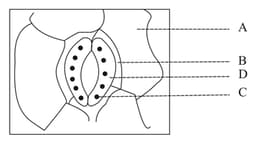In "Pressure Flow" hypothesis, sugars are transported from 'source' to 'sink'. The initial steps which occur during this physiological process are shown here.
I. In leaves glucose is converted to sucrose.
II. Sucrose moves from sieve tube cells to companion cells by active transport.
III. Loading of sucrose produces a hypotonic condition in the phloem.
IV. Water in the adjacent xylem moves into phloem by osmosis.
Identify the above correct statements:

Important Questions on Transport in Plants
Study the diagram and the list given below.

i) Chloroplast
ii) Epidermal cell
iii) Guard cell
iv) Subsidiary cell
v) Stomatal pore
The correct match is
A) Loading of sugars into phloem setup a water potential gradient that facilitates mass movement in phloem.
B) Sucrose moves into companion cell and then to phloem sieve tube cell by active transport.
C) A hypertonic condition in phloem facilitating water from the xylem into phloem by osmosis.
D) All sink sugars are transported out of the phloem producing high water potential with returning of water to xylem.
E) With increase in hydrostatic pressure in phloem pressure flow begin and sap moves through phloem.
In "Pressure Flow" hypothesis, sugars are transported from 'source' to 'sink'. The initial steps which occur during this physiological process are shown here.
I. In leaves glucose is converted to sucrose.
II. Sucrose moves from sieve tube cells to companion cells by active transport.
III. Loading of sucrose produces a hypotonic condition in the phloem.
IV. Water in the adjacent xylem moves into phloem by osmosis.
Identify the above correct statements:
